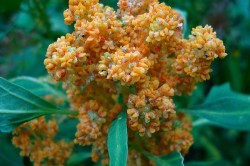A Nutritional Tidbit, on Quinoa
I first heard about quinoa a few years ago, when food-sellers started marketing the stuff as a cereal-like, cholesterol-lowering nutritious substance.

It’s from the Andes, I knew, and comes in some varieties. If you purchase the raw stuff or receive a gift, say, from a Peruvian person who knows her quinoa, you’ll find quickly that you have to rinse it a few times with water before cooking it with whatever seasoning you choose, such as cilantro or just a pinch of salt, or with some olive oil and ground pepper, cinnamon or curry, because the starch has to be rinsed of its saponin (soapy) coating.
What I learned yesterday, beginning with an informative feature in the Times, is that quinoa is not a grain but a seed. According to that article and Wikispecies (a fabulous web-find, in itself), quinoa belongs to the chenopod family or subfamily of plants which includes the likes of beets and spinach. The word chenopod stems from the Greek roots: <chen> (goose) and pod (foot), as in goosefoot. These are said to be flowering plants that lack petals.
The U.S. MyFoodPedia site is devoid of information on quinoa, as is the USDA’s Nutrient Database, as of this morning. Sellers say it’s rich in fiber, protein and minerals. A research study published by agricultural scientists based in Santiago, Chile, found an ideal balance of amino acids and minerals mixed in the starch, along with omega-6 oils and vitamin E.
In my fourth year of medical school, I spent most of two months in Bolivia studying infectious and other diseases in Cochabamba. But I don’t think I ever tried quinoa. And it’s definitely not something I learned about in class.
—
I love Quinoa! Here’s a nice recipe for making it.
http://www.tbtam.com/2010/12/roasted-cauliflower-quinoa-salad.html